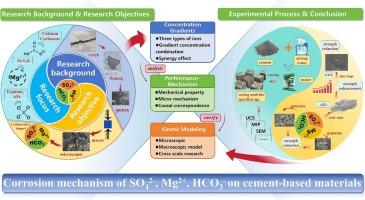Synergistic effects of sulfate, magnesium, and bicarbonate ions in mine water on the hydration, microstructure, and long-term durability of Portland cement paste
IF 5
2区 工程技术
Q1 ENGINEERING, CHEMICAL
引用次数: 0
Abstract
The use of mine water containing aggressive ions as mixing water in concrete poses a significant threat to the long-term durability of cement-based materials. This study systematically investigates the individual and combined effects of sulfate (SO42−), magnesium (Mg2+), and bicarbonate (HCO3−) ions on the hydration behavior, mechanical performance, and microstructural evolution of Portland cement paste. Cement pastes were prepared using simulated ion-containing solutions and evaluated through compressive strength testing, isothermal calorimetry, XRD, TG-DTG, MIP, and SEM analyses. Results indicate that all three ions accelerate early hydration and strength development, with the ternary ion system exhibiting a 73.5 % increase in 7-day compressive strength (from 28.3 to 49.1 MPa). However, prolonged curing results in strength deterioration, particularly under multi-ion conditions, where compressive strength decreases by 25 % (from 55.0 MPa at 28 days to 41.3 MPa at 180 days). Quantitative XRD analysis shows that ion incorporation significantly alters hydration product composition: after 90 days, AFt content decreases from 10.7–11.8 % to 7–9.1 %, while calcite formation increases from 3.5–7.7 % to 3.9–9.5 %, and CH content rises under high-ion conditions, indicating a shift in hydration equilibrium. MIP results reveal that total porosity remains nearly constant (15.3–17.1 %), but mesopore fractions increase from 9.9–13.3 % to 10.5–14.0 %, suggesting progressive pore refinement but reduced matrix integrity. Microstructural observations confirm that deterioration is associated with excessive AFt formation, transformation of C–S–H into M−S−H, and accumulation of CaCO3, leading to increased microcracking and loss of compactness. This study provides new insights into the synergistic and time-dependent effects of aggressive ions on cement hydration and durability. The findings not only elucidate the deterioration mechanisms of ion-contaminated systems but also offer theoretical guidance for mix design optimization, development of ion-resistant binders, and pretreatment strategies to ensure the safe and sustainable use of mine water in future concrete infrastructure.

矿用水中硫酸盐、镁和碳酸氢盐离子对硅酸盐水泥浆水化、微观结构和长期耐久性的协同作用
使用含有侵略性离子的矿井水作为混凝土中的混合水,对水泥基材料的长期耐久性构成重大威胁。本研究系统地研究了硫酸盐(SO42−)、镁(Mg2+)和碳酸氢盐(HCO3−)离子对硅酸盐水泥浆体水化行为、力学性能和微观结构演变的单独和联合影响。采用模拟含离子溶液制备水泥浆体,并通过抗压强度测试、等温量热法、XRD、TG-DTG、MIP和SEM分析对其进行评价。结果表明,三种离子均加速了早期水化和强度的发展,其中三元离子体系的7天抗压强度提高了73.5%(从28.3 MPa提高到49.1 MPa)。然而,长时间的养护会导致强度下降,特别是在多离子条件下,抗压强度下降25%(从28天的55.0 MPa下降到180天的41.3 MPa)。定量XRD分析表明,离子掺入显著改变了水化产物组成:90 d后,AFt含量从10.7 - 11.8%下降到7 - 9.1%,方解石含量从3.5 - 7.7%增加到3.9 - 9.5%,高离子条件下CH含量上升,表明水化平衡发生了改变。MIP结果显示,总孔隙度基本保持不变(15.3 - 17.1%),但中孔分数从9.9 - 13.3%增加到10.5 - 14.0%,表明孔隙不断细化,但基质完整性降低。微观结构观察证实,变质与AFt的过量形成、C-S-H向M - S - H的转变以及CaCO3的积累有关,导致微裂纹增加和致密性丧失。该研究为侵略性离子对水泥水化和耐久性的协同作用和时间依赖性提供了新的见解。研究结果不仅阐明了离子污染体系的恶化机制,而且为优化配合比设计、开发抗离子粘结剂和预处理策略提供了理论指导,以确保未来混凝土基础设施安全、可持续地利用矿山水。
本文章由计算机程序翻译,如有差异,请以英文原文为准。
求助全文
约1分钟内获得全文
求助全文
来源期刊

Minerals Engineering
工程技术-工程:化工
CiteScore
8.70
自引率
18.80%
发文量
519
审稿时长
81 days
期刊介绍:
The purpose of the journal is to provide for the rapid publication of topical papers featuring the latest developments in the allied fields of mineral processing and extractive metallurgy. Its wide ranging coverage of research and practical (operating) topics includes physical separation methods, such as comminution, flotation concentration and dewatering, chemical methods such as bio-, hydro-, and electro-metallurgy, analytical techniques, process control, simulation and instrumentation, and mineralogical aspects of processing. Environmental issues, particularly those pertaining to sustainable development, will also be strongly covered.
 求助内容:
求助内容: 应助结果提醒方式:
应助结果提醒方式:


